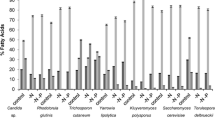Abstract
Saprolegnia sp. 28YTF-1, isolated from a freshwater sample, is a potent producer of 5,8,11,14,17-cis-eicosapentaenoic acid (EPA). The fungus used various kinds of carbon sources, such as starch, dextrin, sucrose, glucose, and olive oil for growth, and olive oil was the best carbon source for EPA production. The EPA content reached 17 mg/g dry mycelium (0.25 mg/L) when the fungus was grown in a medium that contained 2.5% olive oil and 0.5% yeast extract, at pH 6.0 and 28°C for 6 d with shaking. Accompanying production of arachidonic acid (AA; 3.2 mg/g dry mycelia, EPA/AA = 5.1) and other ω6 polyunsaturated fatty acids was low. Both EPA content and EPA/AA ratio increased in parallel by lowering growth temperature. Triglyceride was the major mycelial lipid (ca. 84%), but EPA comprised only 2.2% of the total fatty acids of this lipid. About 40% of the EPA produced was found in polar lipids, such as phosphatidylethanolamine (EPA content, 28.2%), phosphatidylcholine (13.6%), and phosphatidylserine (21.2%).
Similar content being viewed by others
References
Dyerberg, J.,Nutr. Rev. 44:125 (1986).
Kromhout, D., E.B. Bosschietor, and C.D.L. Coulander,New Engl. J. Med. 312:1205 (1985).
Lands, W.E.M., inHealth Effects of Polyunsaturated Fatty Acids in Seafood, edited by A.P. Simopoulos, R.R. Kifer, and R.E. Martin, Academic Press, Toronto, 1986, pp. 319–351.
Braden, L.M., and K.K. Carroll,Lipids 21:285 (1986).
Reddy, B.S., and H. Maruyama,Cancer Res. 46:3367 (1986).
Seto, A., H.L. Wang, and C.W. Hesseltine,J. Am. Oil Chem. Soc. 61:892 (1984).
Hulanicka, D., J. Erwin, and K. Bloch,J. Biol. Chem. 239:2778 (1964).
Yazawa, K., K. Araki, N. Okazaki, K. Watanabe, C. Ishikawa, A. Inoue, N. Nagamori, and K. Kondo,J. Biochem. 103:5 (1988).
Shimizu, S., H. Kawashima, K. Akimoto, Y. Shinmen, and H. Yamada,Appl. Microbiol. Biotechnol. 32:1 (1989).
Shimizu, S., H. Kawashima, K. Akimoto, Y. Shinmen, and H. Yamada,J. Am. Oil Chem. Soc. 66:342 (1989).
Gellerman, J.L., and H. Schlenk,Biochim. Biophys. Acta 573:23 (1979).
Weete, J.D., and S.R. Gandhi, inIndustrial Applications of Single Cell Oils, edited by D.J. Kyle and C. Ratledge, American Oil Chemists’ Society, Champaign, 1992, pp. 97–117.
O’Brien, D.J., M.J. Kurantz, and R. Kwoczak,Appl. Microbiol. Biotechnol. 40:211 (1993).
Lösel, D.M., inMicrobiol Lipids, edited by C. Ratledge and S.G. Wilkinson, Academic Press, London, Vol. 1, 1989, pp. 714–715.
Shimizu, S., H. Kawashima, Y. Shinmen, K. Akimoto, and H. Yamada,J. Am. Oil Chem. Soc. 65:1455 (1988).
Jareonkitmongkol, S., S. Shimizu, and H. Yamada, Ibid.:119 (1993).
Christie, W.W., inLipid Analysis, Pergamon Press, Oxford, 2nd edn., 1982, p. 53.
Bligh, E.G., and W.J. Dyer,Can. J. Biochem. Physiol. 37:911 (1959).
Shimizu, S., Y. Shinmen, H. Kawashima, K. Akimoto, and H. Yamada,Biochem. Biophys. Res. Commun. 150:335 (1988).
Author information
Authors and Affiliations
About this article
Cite this article
Shirasaka, N., Shimizu, S. Production of eicosapentaenoic acid bySaprolegnia sp. 28YTF-1. J Am Oil Chem Soc 72, 1545–1549 (1995). https://doi.org/10.1007/BF02577852
Received:
Accepted:
Issue Date:
DOI: https://doi.org/10.1007/BF02577852




